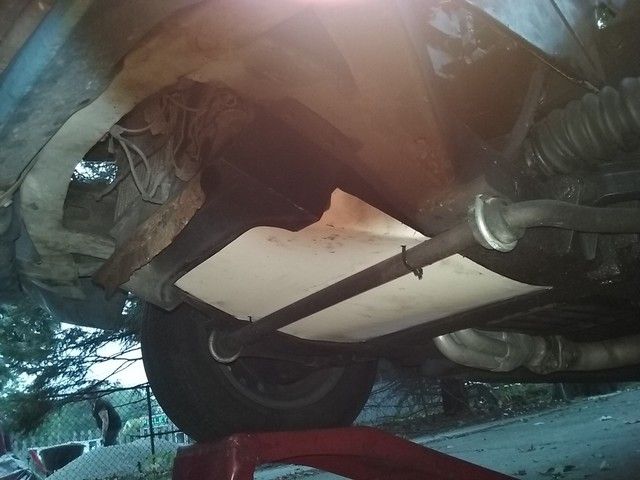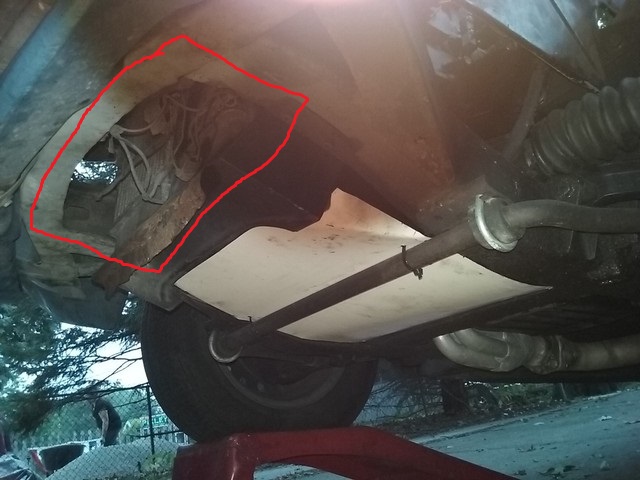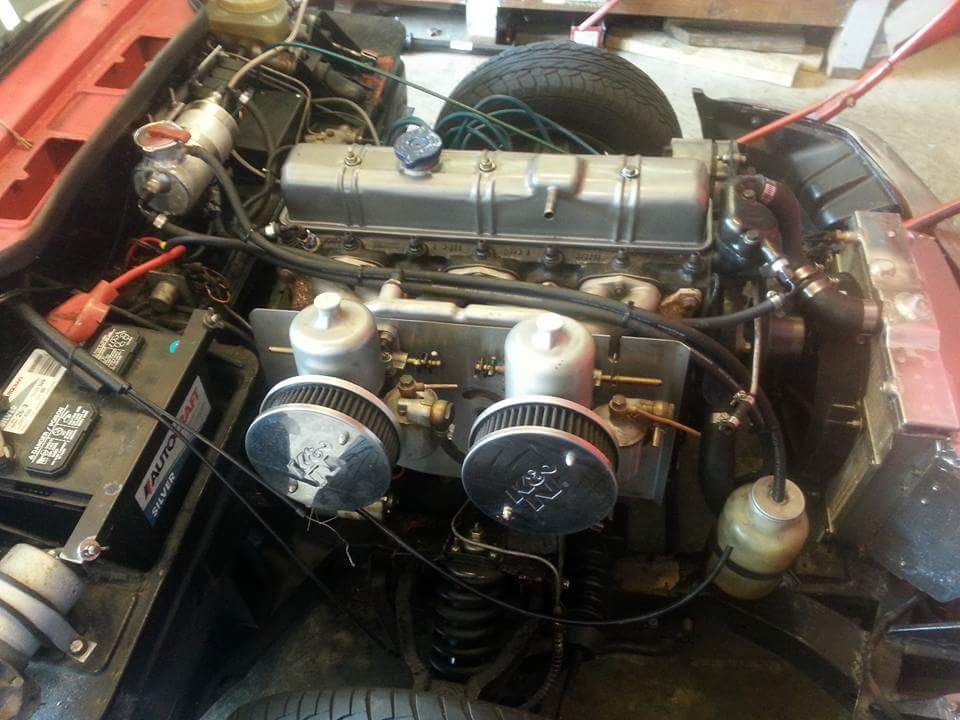Greetings all: My '71 GT6 back in stock form never had a cooling problem - even when stuck in a 45 min stop & go on a hot summer day.
But I upgraded to a slightly warmed over 2.5L TR6/TVR engine and upgraded the radiator core from stock 3 row core to a high efficiency 5 row core. The rad boiled over the first time during engine break-in while stuck in a construction zone. I added a pusher fan in front of the rad and it would barely keep the car from overheating when in extended stop and go. I tried to replace the radiator fan w/ a puller elect fan - even worse. I switched off the elect fan while on the freeway at 70+ mph and the temp began to spike (does the same at 40 mph also). It appears that I simply do not have enough radiator cooling capacity.
I am thinking of going to a cross flow radiator. Anyone have any experience with the "Sciroco" (also advertised as Pro Stock) radiators? An example: http://www.jegs.com/i/JEGS-Performance-Products/555/51965/10002/-1 These appear to be the smallest mass produced cross flows readily available and I *think I just might be able to make it package (if I also use two small elect fans side by side) since I will not be able to use a cross flow and the stock belt driven fan). If these radiators are actually used in Pro Stock cars w/ big V8s, I should be able to keep my 2.5L engine cool. Or are these rad used for drag vehicles only and not used on the street?
Spit bodied GT6, 2.5L, triple Webers, 6 to 1 headers, smog head milled 0.140 in, Goodparts GP2 cam (and a Ro-Spit inspired diff made up of parts from RX7/Miata/rwd626)
Do you have other issues? Such as: A water pump that is damaged internally? Some kind of thermostat failure? Try taking the thermostat out completely and see if it still overheats. If all that is OK, then the optimal mixture for cooling purposes while still retaining anti-freezing effects is 1/3 antifreeze (I use Toyota Red in everything) and 2/3 distilled water, plus a bottle of Water Wetter.
Yeah something else is wrong there, it's not the radiator design, which is actually excessive to the point of waste in terms of rows. I'm also thinking that radiator needs to be boiled and/or rodded.
The most efficient radiator configuration is the 3-row 3-pass, with fluid flowing first into the back row and finishing on the front row.
We're running a heavily modified TR6 engine for autocross with a stock radiator and have no such issues. We sit idling for over 10 minutes between runs. I too would suspect some other issue. Check whether the thermostat is sticking. Was the block water jacket filled with crud (i.e., does the block drain work)? Do you have a shroud in front of the radiator? If the radiator cap is below the thermostat, you could have the same issue as TVRs with air trapped in the cooling system.
Thanks for the quick responses. I have been fighting this issue since upgrading to the 2.5L (and 5 row rad core) 18 yrs ago. Duct in front of rad. Chin spoiler under lower rad tank to create low pressure area behind rad. Tried water Wetter with minimal coolant. Recent water pump rebuild with upgraded 6 vane impeller. From memory, TR6 rad larger surface area vs GT6 rad. The 5 row core my be hurting rather than helping. Block drain works, block was hot tanked when bored over - no idea if there is a casting defect in the water jacket. I have no prior history with this 2.5L prior to rebuilding and installing (have about 70K miles since rebuild) - wish I had kept my original 2.0L block and swapped in the 2.5L crank.
So, back to my question, any experience with the Sciroco style cross flow rad? With how big of an engine?
What type of fans are you trying? I had nothing but trouble with mine when I was using the standard parts store grade fans. A heavy duty Spal puller fan works wonders over the cheapo fans. I ended up with an 11" Spal 30102054.
I also converted over to a ebay Honda Civic "racing" aluminum 2 row radiator and built a very tightly fitting shroud. This setup keeps temps well under control in traffic, cruising, and even keeps up easily when autocrossing with 3 drivers same heat on a 90+ degree day. My engine is a 2.0L, but rather hopped up with 10.6:1, GP3 cam, HD8 carbs...
Since your overheating issues are showing up during cruising, I don't think you are putting much extra heat load into the system 2.0L vs 2.5L.
Add one more vote for a possible issue with your reworked rad, or like you mentioned maybe a block issue.
Jason
I have a Scirocco style 2row radiator (2inch core) on a 1300cc bike engined sports racer that makes about 185 whp. It cools fine on track with no fan.
I also have a TR6 (stock rad) without the mechanical fan and it only needs the electric fan when sitting still. So I'm not sure the rad. is your issue.
I have a 16V Scriocco that has a radiator a bit bigger then the one mentioned. I have no cooling issues with a IT spec motor and I have run it hard on warm days and the temp gauge which is located in the hose that feeds water to the radiator never get's close to 200 degrees and usually is steady at 180-185. The thermostat is a 180 deg one so it's working and the engine runs fine.
Pictures of the radiator installation might reveal something you're missing.
What's the ignition timing situation on this engine? Insufficient advance at idle and light loads will make it run really hot.
We ran the Group 44 GT6 at places like the Monterey Historics and had no cooling issues with a very highly modified 2.0 liter Triumph engine. We used a stock sized and stock looking Aluminum radiator from Ron Davis. Something is wrong, as this is not a hard car to cool.
Again thanks for the responses. Image of rad shroud - looking down on rad & shroud: http://i290.photobucket.com/albums/ll272/aribert/Triumph/20151006_184541_zpsjihaiidl.jpg Side view of rad, shroud, elec fan (sourced from Hyundai (Sonata or Elantra - without looking it up I don't remember, very close to 12 inch dia, draws 16A steady w/ inrush of 20+A) http://i290.photobucket.com/albums/ll272/aribert/Triumph/a0ab5fc0-346e-426d-be38-5dd4cd3711a7_zpsbvkwn9op.jpg
Ignition timing is at 18 BTDC but has been anywhere from 12 to 22 BTDC. Dist was rebuilt and recurved a couple of years ago. 160F T-stat; begins to crack open at 155 and is fully open at 165F. Cooling system begins to percolate into (and out of) the overflow bottle when the needle is centered on the red square on the stock gage.
My Photobucket Triumph subfolder has gone wonky while writing this message, I have waited for 10 min for it to reload so I could see if I had any more rad related pics but and I am unable to get the subfolder to reopen to be able to harvest anymore pics.

we definitely need more pics to be able to help. Especially any aero work to the nose, and any ducting that pushes air towards the radiator.
I think one of the issues with the 5 row is air does NOT want to go through it. If the ducting to it from the grill has any leaks, it is going to escape that way rather than getting through a highly aero-inefficient radiator
In reply to aribert:
Vacuum advance? That's what gives it the extra timing it needs under light load.
Looking at your pics, the two things that I'd try: 1) Make a plate to close off the bottom opening in front of the rad down thru the frame. High pressure air might be going down there instead of thru the rad.
2) The fan shroud itself is blocking a large % of the radiator making it hard for air to flow thru when at speed. This shroud is probably good when you are stationary, but it's certainly hurting anytime the car is moving. I'd go with a fan without a shroud. (Keep the ducting in front of the rad though, that's certainly HELPING).
Jason
I'd say do more than lose the front fan shroud, lose the pusher fan setup entirely. It cooled the car better at a stop but that's all it has going for it. A puller is just a better setup - it maximizes airflow into the radiator when moving and, all else being equal, would work just as well as a pusher when parked. Go back to the puller fan and it should work fine once you find and fix what's actually causing this car to run hot.
THank you all for following along with this thread.
Working backwards to the responses. The pusher fan was removed when I went the puller fan in place of the stock belt drive fan. With the stock fan, the pusher was required to be able to drive in stop and go traffic. I am not following the fan shroud comment. I am guessing it is related the the temp lower shroud under and behind the rad (taupe colored sheet metal) THis was a two week only trial and I did not intend to post it - my Photobucket account got wonky last night. THis is what I intended to show of the front shroud; top view: http://i290.photobucket.com/albums/ll272/aribert/Triumph/Sight_2016_05_09_224219_075_zpsrllrgofd.jpg side view: http://i290.photobucket.com/albums/ll272/aribert/Triumph/a0ab5fc0-346e-426d-be38-5dd4cd3711a7_zpsbvkwn9op.jpg My aluminum shroud minimcs the Triumph carboard shroud but the opening in the front is a bit wider to grab more air when moving. I also cut openings in the front cross-member for air flow to the rad: http://i290.photobucket.com/albums/ll272/aribert/Triumph/Sight_2016_05_09_224857_247_zpsib6ayh37.jpg
This is my current Hyudia puller fan in place of the stock belt driven fan: http://i290.photobucket.com/albums/ll272/aribert/Triumph/IMAG0727_zps9421d871.jpg http://i290.photobucket.com/albums/ll272/aribert/Triumph/IMAG0713_zpsc7e5466b.jpg
Vacuum adv - I'm not using any - Weber DCOE carbs do not have a port vacuum tap. I could use manifold vacuum downstream of the carbs.
I have come to the same conclusion that the 5 row rad core is not helping and might be / probably is hurting my situation. This rad was recored with what is called a high efficiency core - 3/8 inch tube spacing instead of 1/2 inch and denser fins (again more of an air block in a multi row core. It sounded good at the time (more water capacity since more tubes and more heat trans with more fins).
My experience is that at vehicle speeds above 35 to 40 mph, a cooling fan is redundant. What I found out when I replaced the stock belt driven fan & pusher fan combo with the puller fan is that my car needs a fan on most the time that I am driving even on the freeway when its rather cool - 50F ambient.
I am hesitant to just have the rad recored with a stock 3-row core. At this point I just want much more cooling capacity - even if the car should not need it. I suspect that the engine has about 40K miles left in it before a rebuild is due - at which time the water jacket can be thoroughly checked out to see if there is any foreign material that might cause hot spots. THe last two years with the elect puller fan I have not driven the car if the amb temp was over 80F and I expected to be in stop and go traffic. I have gotten used to driving by watching the temp gage and noticing the first smell of coolant perculating: http://i290.photobucket.com/albums/ll272/aribert/Triumph/gage%20reading_zpsmsyo1ftg.jpg
Have you tried it with no thermostat?
If you're sure there's no air pockets and the pump is working, all that's left is that your radiator isn't working properly, or the thermostat is bad and not opening under pressure.
I've actually never heard of a 5 row radiator before. 3 row radiators are considered a row too far in some circles.
This radiator, is it 2 pass now or single pass? 2 pass radiators, like in a Europa, can lose the baffle plate and become 0 pass, causing problems.
Also, when this thing is sitting there idling and getting hot, take an IR pyrometer and start scanning various part of the radiator. Same temps? Check the hoses, etc.
I have two Scirocco-style dual pass radiators on my RX7 hillclimber. They're mounted in the back.
They cool my ported out 13B no problem even without great airflow.

Here is the area that I have added a plate hoping to force the high pressure air thru the rad instead of coming out the bottom.

Here is what I'd recommend for a fan, puller fan but no fan shroud around the fan to block off rad area (front ducting was not installed yet in this pic).

Here you can just make out the ducting in front of the radiator. Was a nice improvement and fits much closer than the OEM cardboard one.

Jason
aribert wrote: Vacuum adv - I'm not using any - Weber DCOE carbs do not have a port vacuum tap. I could use manifold vacuum downstream of the carbs.
I'd try that, as I understand it what happens is when you're idling and cruising along the carbs tend to lean out as they are designed to do. This is fine and dandy if you light off that slower burning lean mix earlier by using the high manifold vacuum in those conditions to add timing advance. Otherwise you're pumping the still burning charge though the exhaust ports where it dumps it's energy entirely into the cooling system, rather than partially into turning the crankshaft.
Ported vs manifold vac is a driveability thing that seems to mostly depend on how the mechanical advance has been curved, if it drives ok with no vac advance it will drive ok on manifold vacuum advance. Most smog era cars had a thermostatic valve that switched it back and forth, it would automatically put the distributor on manifold vacuum if the engine started overheating.
Where is the air supposed to go after it goes through the radiator? Usually, after the air goes through a radiator, it goes down, between the radiator and engine and flows out under the car. It looks like the white plate in the pic blocks that area off. Seems that would make it hard to get the air out. The 5 row is restrictive anyway. With no good way out after going through the rad, air will choose to just go down and out before going through the radiator. I would take out the white plate, block the area that jasonmf highlighted in red and try it. That should force the air to go through the radiator and give it some place to go after it gets through.
OK I will add a panel where the red outline was. The light colored panel on my car was only there for 2 wks to see if I could induce a low pressure area behind the rad. The rad is single pass.
I have checked the rad for hot or (relatively speaking) cool areas. The temp distribution appeared to be uniform - and slightly warmer at the top than the bottom. I do not remember the actual numbers.
I have not considered running w/o a T-stat. I'll do that. I have changed the T-stat several years ago when the former t-stat stuck closed at first start up in the spring. No change in how the engine runs hot the season before or the season after the t-stat change.
I'll also try a vac advance using manifold vacuum. I tried using manifold vacuum on my '61 Falcon several years ago - it was almost undriveable.
GameBoy - the 3 row, 3 pass back to front cooling path rad that you speak of - are these custom fabb'ed or something available "off the shelf"?
Titan just asked where does the air go after the rad - one thing on my car is that the air can not go down the trans tunnel (no idea how much might flow there anyway). I bought one of those vac formed plastic trans tunnels, applied spray foam insulation to the underside and carved away enough to clear the trans and then sealed the foam w/ fiberglass cloth and polyester resin.
You'll need to log in to post.